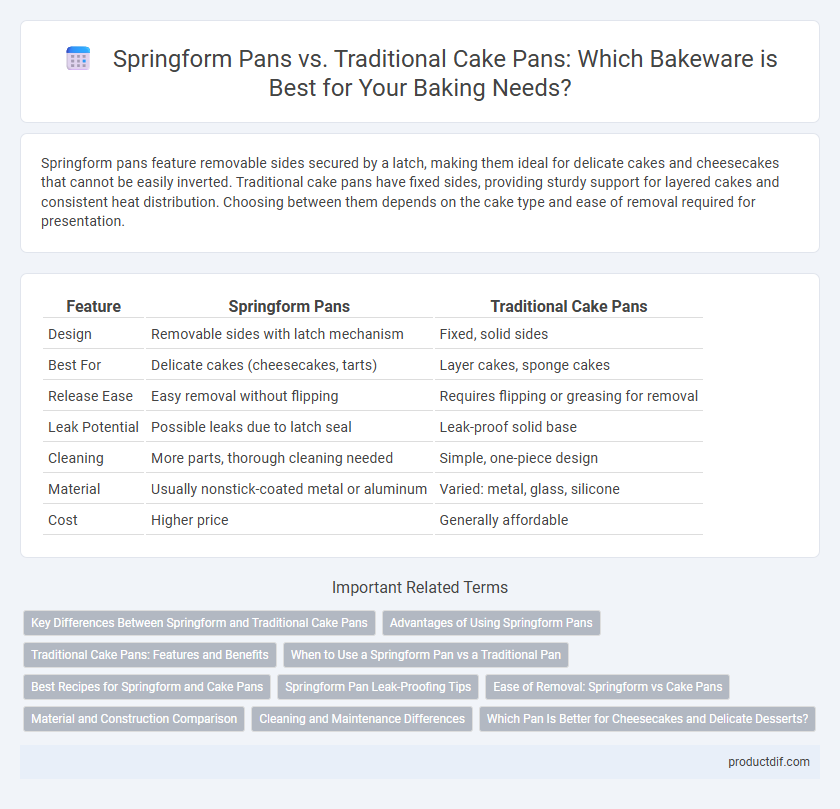Springform pans feature removable sides secured by a latch, making them ideal for delicate cakes and cheesecakes that cannot be easily inverted. Traditional cake pans have fixed sides, providing sturdy support for layered cakes and consistent heat distribution. Choosing between them depends on the cake type and ease of removal required for presentation.
Table of Comparison
| Feature | Springform Pans | Traditional Cake Pans |
|---|---|---|
| Design | Removable sides with latch mechanism | Fixed, solid sides |
| Best For | Delicate cakes (cheesecakes, tarts) | Layer cakes, sponge cakes |
| Release Ease | Easy removal without flipping | Requires flipping or greasing for removal |
| Leak Potential | Possible leaks due to latch seal | Leak-proof solid base |
| Cleaning | More parts, thorough cleaning needed | Simple, one-piece design |
| Material | Usually nonstick-coated metal or aluminum | Varied: metal, glass, silicone |
| Cost | Higher price | Generally affordable |
Key Differences Between Springform and Traditional Cake Pans
Springform pans feature removable sides secured by a latch, enabling easy release of delicate cakes without inverting, while traditional cake pans have fixed sides requiring cake inversion for removal. Springform pans are ideal for cheesecakes and multi-layer desserts, offering gentle handling, whereas traditional pans are better suited for standard cakes and brownies that can withstand flipping. Material variations also influence heat conduction and baking times, with non-stick coatings commonly found in springform pans for improved release.
Advantages of Using Springform Pans
Springform pans offer easy cake removal due to their removable sides, minimizing damage to delicate baked goods like cheesecakes and tortes. Their adjustable latch mechanism provides a secure fit, reducing leakage compared to traditional cake pans. These pans also enhance versatility by allowing baking and serving in the same container, simplifying presentation.
Traditional Cake Pans: Features and Benefits
Traditional cake pans, typically made from materials like aluminum, stainless steel, or silicone, offer durable, even heat distribution for consistent baking results. Their fixed sides provide stable structure, making them ideal for layered cakes, brownies, or sheet cakes that require firm edges. These pans are easy to use, clean, and come in various shapes and sizes to suit a wide range of baking needs.
When to Use a Springform Pan vs a Traditional Pan
Springform pans are ideal for delicate desserts like cheesecakes and layered cakes that require gentle removal without flipping, preventing damage to the structure or design. Traditional cake pans excel for standard sponge cakes or batter-based recipes that benefit from even heat distribution and easy cooling after baking. Choosing a springform pan enhances presentation for intricate cakes, while traditional pans offer versatility for everyday baking tasks.
Best Recipes for Springform and Cake Pans
Springform pans are ideal for delicate desserts like cheesecakes, mousse cakes, and tortes due to their removable sides that prevent damage during release. Traditional cake pans excel for layered cakes, pound cakes, and brownies, providing sturdy structure for even baking and shaping. Recipes such as classic New York cheesecake benefit from springform pans, while butter cakes and sponge cakes perform best in traditional round or square cake pans.
Springform Pan Leak-Proofing Tips
Springform pans can be prone to leaks if not properly secured, so always ensure the gasket is tightly sealed and the clasp fully locked before pouring batter. Wrapping the bottom and sides with aluminum foil helps prevent leakage during baking, especially for thin batters. Using a silicone springform pan or placing the pan on a baking sheet adds extra protection against spills.
Ease of Removal: Springform vs Cake Pans
Springform pans feature removable sides secured by a latch, allowing for easy release of delicate cakes without flipping or inverting, which reduces the risk of damage. Traditional cake pans require inversion or careful loosening to remove cakes, often leading to broken edges or stuck batter. For cheesecakes, tortes, and other delicate desserts, springform pans offer superior ease of removal compared to standard cake pans.
Material and Construction Comparison
Springform pans typically feature a two-piece design with a removable latch that allows the sides to expand and release from the cake, often crafted from heavy-gauge aluminum or non-stick coated steel for durability and even heat distribution. Traditional cake pans are generally made from solid aluminum, stainless steel, or sometimes glass, providing consistent heat conduction but lacking the flexible design of springform pans. The construction of springform pans includes a seal to prevent leaks, making them ideal for delicate desserts like cheesecakes, whereas traditional pans offer sturdier, more rigid forms suited for standard cakes and layered baking.
Cleaning and Maintenance Differences
Springform pans feature removable sides and bottoms that simplify cleaning by allowing easier access to all surfaces, preventing batter from sticking in corners. Traditional cake pans usually have fixed sides and require more thorough scrubbing, especially along seams and edges where residue tends to accumulate. Non-stick coatings on springform pans often demand gentle washing with soft sponges to maintain durability, whereas traditional metal pans can withstand more rigorous cleaning methods.
Which Pan Is Better for Cheesecakes and Delicate Desserts?
Springform pans feature removable sides that allow for easy release of delicate cheesecakes without damaging their shape, making them ideal for intricate desserts. Traditional cake pans have fixed sides and can cause difficulty when removing delicate cakes, often requiring inversion that may compromise texture. For cheesecakes and fragile baked goods, springform pans provide superior results due to their secure yet removable design.
Springform pans vs traditional cake pans Infographic

 productdif.com
productdif.com